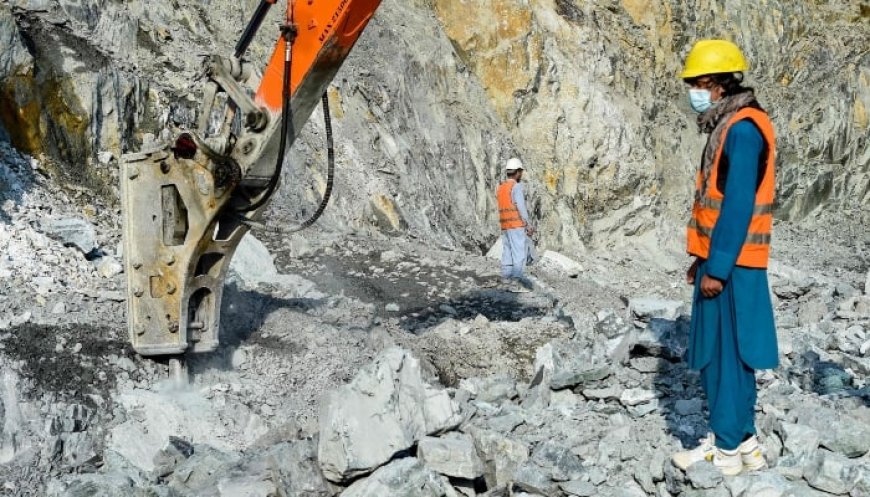Taliban eye Afghanistan's mineral wealth for revenue boost

1. Afghanistan's mineral resources estimated at $1 trillion, according to US and UN assessments
A miner in the mountains of eastern Afghanistan poured water over a block of jade, revealing the green stone that is part of the Taliban's efforts to capitalize on the country's abundant mineral resources.
Promoting the return of stability, the Taliban government is rapidly courting both local and foreign investors to exploit the nation's underground wealth, aiming to secure an essential source of revenue. However, experts warn that this rush to profit could come at the cost of safety and environmental considerations.
Afghanistan is rich in minerals, including emeralds, rubies, marble, gold, and lithium, with estimates suggesting these resources could be worth up to a trillion dollars, according to U.S. and U.N. assessments from 2010 and 2013. While these reserves remained largely untapped during decades of war, the Taliban has signed approximately 200 mining contracts since retaking power in 2021, the majority of them with local companies, worth billions of dollars.
"We want Afghanistan to be self-sufficient, but there are challenges," said Humayoun Afghan, spokesman for the Ministry of Mines. "We lack experts, infrastructure, and knowledge." He added that the Taliban is open to investments, especially from those with mining experience.
Many of these contracts focus on exploration, a process that can take years to yield results, while less-regulated extraction practices may lead to significant environmental damage, experts caution. The U.S. Geological Survey (USGS) noted a sharp increase in the production of coal, talc, and chromite in 2021 and 2022.
The Taliban is prioritizing resources that could appreciate in value, like lithium, whose prices may rise on global markets. The Ministry of Mines regularly publishes tenders for exploration and extraction projects and invites foreign companies to apply.
According to the World Bank, the mining sector grew by 6.9% in 2023-2024, driving a 2.6% increase in the industrial sector. However, many of the contracts awarded since the Taliban’s return have yet to begin operations.
Javed Noorani, a mining sector expert, believes the government is offering far more projects than its capacity to manage them.
The Taliban, which waged a two-decade insurgency against the U.S.-backed Afghan government, seized power in 2021 after foreign troops withdrew. Although security has significantly improved, most foreign investors fear being associated with the unrecognized "Islamic Emirate," which remains under Western sanctions. However, countries like Iran, Turkey, Uzbekistan, and Qatar, along with China, have seized the opportunity.
"The first thing investors tell us is that the country has been stabilized, and now they want to invest," said Afghan, estimating that 150,000 jobs have been created in the sector since 2021.
Despite the improvements in stability, sporadic attacks by Daesh, including the killing of a Chinese mine worker in northern Takhar province in January, have raised concerns.
China is leading the charge in Afghan mining, with the state-owned MCC already operating at the Mes Aynak copper deposit, the second-largest in the world. Chinese companies have secured at least three other major mining projects in gold and copper, Afghan noted.
At a jade mine in Goshta, eastern Nangarhar province, nephrite is extracted for use in jewelry, with the majority of the material exported to China. Habibrahman Kawal, co-owner of the mine, is optimistic about his thriving business, having entered mining only after the Taliban takeover.
Currently, only 14 mining companies are operating in Afghanistan, down from the previous government's era, suggesting that a new set of companies now controls the sector.
While the government has declined to disclose revenue figures, it profits by taking stakes in some companies and collecting royalties.
Shir Baz Kaminzada, president of the Afghanistan Chamber of Industries and Mines, noted that some investors disregard international sanctions, knowing they can profit in Afghanistan where mining regulations are minimal. "In places with strict regulations, you'd spend billions to start a mine. In Afghanistan, with very little experience and few regulations, companies have an advantage," said geophysicist David Chambers, president of a nonprofit providing technical assistance in mining.
This lack of regulation enables quicker work but could result in environmental and economic harm. The main concern is mine waste, as only 1% of excavated material is removed, and the rest may contain harmful minerals that contaminate the ground if exposed to water.
The Ministry of Mines claims to follow existing legislation to ensure mines are "cleaned" after extraction, though it provided few details on this process. "Every dollar you don't spend on a safe tailings dam or water cleanup is profit," said Chambers, "but it could lead to significant long-term costs."
Kaminzada admitted that "people are not taking care of the long term."


















































